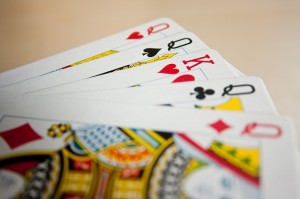Seven-card stud is the most popular form of poker in the United States. It is the foundation on which all home games were built on and every casino offers it. Seven-card stud poker attracts more casual players than Texas hold’em poker. Even if there is stiff competition between these two, seven-card stud has always managed to stay ahead and the game of choice.
Seven-card stud walkthrough:
In this walkthrough of seven-card stud, we’ll give you an easy example of play. A low-stakes game of $1 to $4 will do.
Each player at the table is dealt three cards to begin the hand. Two face-down cards and one face-up. The player with the lowest-ranked upcard must make a bet called the “bring-in”. Please keep in mind that this bet is required. The amount of the bring-in will vary according to the table-limits but is generally lower than the minimum bet. In this example, we’ll use a bring-in bet of $0.50. When two or more cards are tied as lowest, the card suits will be used to break thee tie. This is the only time that a card suit has a ranking. Suits are ranked alphabetically from the lowest to the highest just like in a game of bridge. Clubs, diamonds, hearts and spades. So f you have let’s say, a 2 of spades, you will be guaranteed to make the bring-in bet.
Betting will always move in a clockwise motion around the table. If a player makes the bring-in bet, the player on the left will have three options. Call, raise or fold. If the player chooses fold, he or she would have to have to turn the face-up card, face-down and the dealer will collect the cards. If the player calls, the bring-in bet must be matched. If the player raises, the player must raise by a full dollar increment such as $1,$2, $3 or $4.
The player next in line will also have the three options and the same is true for the rest. So let’s say player 2 raised to $3 and three others have stayed in while the other three folded. The betting has come back to player 1 and he or she can assert his or her free will. Player 1 can call by putting in $2.50 ($0.50 was the original bet), reraise or fold.
After the first round f betting, the players will receive a face-up card and move on to “fourth street”. Street refers to a round of betting after a card has been dealt. In this round, the player with the highest hand will act first. If two hands have the same value, the one closest to the dealer’s left will act first. The player can either check or bet. A check is indicated by knocking hi or her knuckles on the table and/or saying “check”. This means that the player chooses not to bet and is passing the option t next active player. A player that checks have the option to call or raise when the betting comes around again.
If everyone checks, the round is over and the next card is dealt. If any player bets, all the players must respond with a fold, call or raise. This process is repeated for two more face-up cards (fifth and sixth street) and the final face-down card (seventh street or “the river”) . There is a round of betting with each round and the player with the high hand showing (“on board”) will act first. In total, there will be five rounds of betting. Please take note that a round can end sooner if a player makes a bet that nobody wants to call.
In the end, each active player will have three face-down cards and four face-up cards. After the final round of betting, the showdown will take place. The last person to raise will reveal his hand and then the remaining players will revel theirs. The dealer will then determine the wining hand.
Remember that the player who can make the best possible hand out of his or her 7 cards, will be declared the winner. The dealer will then push the pot to the player and the next game will begin.



